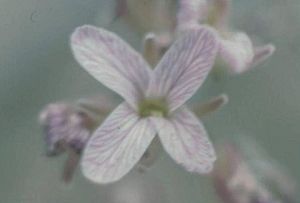Schoenocrambe argillacea facts for kids
Quick facts for kids Schoenocrambe argillacea |
|
|---|---|
 |
|
| Conservation status | |
| Scientific classification | |
| Kingdom: | |
| (unranked): | |
| (unranked): | |
| (unranked): | |
| Order: | |
| Family: | |
| Genus: |
Schoenocrambe
|
| Species: |
S. argillacea
|
| Binomial name | |
| Schoenocrambe argillacea (S.L.Welsh & N.D.Atwood) Rollins
|
|
| Synonyms | |
|
Hesperidanthus argillaceus |
|
Schoenocrambe argillacea is a very rare flowering plant. It is part of the mustard family. People also call it the clay reed-mustard or Uinta Basin plainsmustard. This plant is special because it only grows in one small area.
Where Does It Live?
This unique mustard plant is found only in a specific part of northeastern Utah. You can only find it in Uintah County. This means it is an endemic species. It doesn't grow naturally anywhere else in the world!
The plant lives in the Uinta Basin. This area has special rock formations like the Green River Formation. Its home is rocky, with steep cliffs made of gypsum-rich clay. These cliffs are often covered with sandstone scree, which are small loose rocks.
The ground is often bedrock or shale. It has loose rocks and fine soil. The plants grow in open, sunny spots. They also grow in sheltered areas, like small nooks in the rocks. The biggest plants are often found in these protected spots. This area is a desert, so it's a desert shrub habitat.
Other plants that share this habitat include Torrey's jointfir, shadscale, and black sagebrush. These plants are all adapted to living in dry, rocky conditions.
What Does It Look Like?
The Schoenocrambe argillacea is a perennial herb. This means it lives for more than two years. It has one or more straight stems. These stems grow from 13 to 30 centimeters tall. That's about the length of a ruler!
Its leaves are long and narrow, like lines. They can grow up to 4 centimeters long. The edges of the leaves are smooth. They are also a bit fleshy and have a white, waxy coating. This waxy layer helps the plant save water in its dry home.
The plant's flowers grow in a cluster called a raceme. This is a type of inflorescence. The flowers look like other mustard flowers. Each flower has purple sepals. It also has four white or pale purple petals. These petals are about a centimeter long and have pretty purple lines.
After the flowers bloom, the plant produces fruit. The fruit is a curved pod called a silique. These pods are usually 2 to 5 centimeters long.
Why Is It Important to Protect It?
This plant is very rare. It is listed as a Critically endangered species in the United States. This means it is at a very high risk of disappearing forever.
There are only a few groups of Schoenocrambe argillacea plants left. They are all in a small part of the Uinta Basin. Scientists believe there are fewer than 10,000 plants in total.
The biggest danger to this plant is oil and gas exploration. This activity happens in the plant's habitat. There is also a risk from mining oil shale in the area. Another threat is the use of off-road vehicles. These vehicles can damage the plant's delicate home. Protecting this plant helps keep our planet's amazing biodiversity safe.


